 |
 |
 |
| |
The Effect of Atazanavir vs Lopinavir/ritonavir on Insulin-Stimulated Glucose Disposal Rate in Healthy Subjects
|
| |
| |
Mustafa Noor, MD, and colleagues reported the results from this study at the 11th Annual Retrovirus Conference. (DM Grasela, RA Parker, D Tackett, H Uderman, A Currie, S Agarwala, C Grunfeld, M Giordano, S Hodder, F Fiedorek, E O'Mara; Bristol Myers Squibb, University of California, San Francisco).
Following is text from poster 702.
INTRODUCTION
Treatment with some HIV protease inhibitors (PI) has been associated with insulin rrsistance, hyperglycemia, and development ofdiabetes mellitus (1,2). Induction of insulin resistance by a PI precedes any significant changes in lipids, lipoproteins, or body composition (3) and can be detected after a single dose of indinavir (IDV) in healthy volunteers (4). In vitro studies suggest blockade of the insulin-regulated glucose transporterm GLUT-4, as a possible mechanism for PI_associated insulin resistance (5). Atazanavir (Reyataz) (ATV) is a new PI that, unlike IDV< lopinavir (LPV), and ritonavir (RTV), does not block GLUT4 activity (6). At the end of thisreport you can view slide of cartoon showing mechanism of glucose transport through GLUT4, and a cartoon slide of the effect of various protease inhibitors on GLUT activity in vitro. This study assesses insulin-stimulated glucose disposal and glycogen storage rates in healthy volunteers taking ATV compared to those taking lopinavir/ritonavir (LPV/r) or placebo.
Comments by Jules Levin: The results of this short term highly intensive study in healthy volunteers suggests that atazanavir has favorable effects on glucose metabolism compared to lopinavir/r (Kaletra) and perhaps to other protease inhibitors although this study did not examine them. We have seen in clinical studies of HIV-infected patients that atazanavir has favorable effects on glucose compared to other HIV drugs. The benefits are more clear for treatment-naïve individuals; for treatment-experienced individuals with abnormal glucose, treatment affected insulin resistance, and for individuals with diabetes, the benefits of atazanavir need further study but may be or are likely to have benefit.
At the end of this report you can see a slide showing that IGT/Pre-diabetes (ADA defined) was found in 35% in HIV+ individuals with lipodystrophy vs 5.2% in healthy individuals (matched control Framingham n=213) (Hadigan C et al. Clinical Infectious Diseases 32:130-9, 2001). The diabetes rate was 7% in HIV+ individuals vs 0.5% in the control group.
The study authors concluded: ATV did not effect insulin sensitivity and had no effect on insulin-mediated glucose disposal rates as measured by the gold-standard glucoseclamo technique. In contrast, LPV/r induced significant insulin resistance when compared to both placebo-treated and ATV-treated subjects. LPV/r reduced the mean glucose disposal rate by 23% relative to ATV and by 24% relative to placebo. ATV had no effect on the mean glycogen storage rate. In contrast, LPV/r significantly reduced the mean glycogen storage rate by 36% relative to ATV and by 34% relative to placebo. ATV did not significantly increase fasting triglycerides. In contrast, LPV/r significantly increased the mean fasting triglycerides by 35% compared to ATV and by 43% compared to placebo. Our findings are consistent with in vitro studies of glucose uptake and confirm the favorableclinical metabolic profile of ATV.
Studies of indinavir and its effect on glucose show negative effects; these studies were conducted by Noor and slides of these study results are at the end of this report. All slides that you cannot view in this email are due to the limits of email but can be seen when this full article along with slides is posted to the NATAP website at http://www.natap.org
STUDY FINDINGS
Consistent with in vitro (test tube) observations, we found that ATV did not have an effect on glucose disposal while LPV/r adminstration resulted in insulin resistance when compared to both ATV and placebo. This is also consistent with the early favorable profile of ATV on glucose metabolism observed in clinical trials. Plasma concentrations of PI drugs are highly variable as are individual subjects' sensitivity to insulin. We measured glucose disposal rates near peak plasma concentration for lopinavir and atazanavir at comparable insulin levels.
Insulin-stimulated glucose disposal rates were consistently lower in individuals on LPV/r compared to both placebo and ATV. The magnitude of this effect was about 24% and within the range of the effect previously reported on IDV (4,5). The decrease is comparable in magnitude to tota hepatic glucose producyion in fasted healthy individuals (about 2 mg/kg/min).
Our findings are in contrast to those by Lee et al who found little or no decreasein insulin-stimulated glucose disposal after 4 weeks of treatment with LPV/r in healthy volunteers (8). However, in that study insulin resistance was detected by oral glucose tolerance testing. In addition, Lee et al observed significant increases in serum concentrationsof free fatty acids and triglycerides, both known to be associated with insulin resistance.
Although we have studied acute effects in healthy men, long term results from clinical trials indicate that the extent and severity of metabolic complications are compounded by HIV and occur regardless of gender, suggesting clinically important adverse effects af ARV therapy on insulin sensitivity across diverse patient groups.
METHODS
After giving informed consent, healthy HIV-seronegative volunteers enrolled into the study. We excluded subjects with body masss index >30 kg/m2, serum total cholesterol >240 , triglycerides >200 mg/dl, fasting glucose >126 mg/dl, serum aspartate or alanine aminotransferases >50 U/I and creatinine >1.4 mg/dl.
STUDY DESIGN: This was a randomized, double-blind, placebo-controlled, 3-treatment, 2-period cross-over study. All subjects were admitted to Bristol Myers Squibb Clinical Pharmacology Unit (CPU) as inpatients for 6 consecutive days. Subjects were randomly assigned to receive atazanavir (Reyataz) 400 mg daily, lopinavir/ritonavir (Kaletra) 400/100mg twice daily, or matching placebo. On the morning of day 6, a glucose clamp was performed. Treatment was discontinued on day 7 and the subjects were discharged from the CPU. One to two weeks later subjects returned at which time they were randomly crossed over to an alternate treatment arm for repeat studies (fig 1). Each subject was studied on 2 of 3 possible treatments using the hyperinsulinemic euglycemic clamp technique (180 minutes) with ≥14 days of washout between studies.
Figure 1: Study Design
|
|
| |
| |
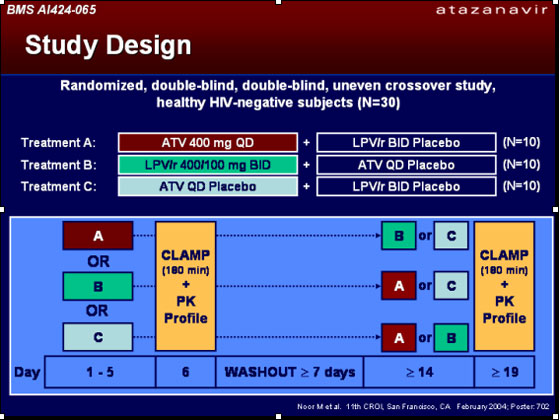 |
|
| |
| |
Hyperinsulinemic Euglcemic Clamp: The clamp was performed as described by De Fronzo et al (7). Insulin was administered as a primed continuos intravenous infusion, followed by a constant infusion at the rate of 40 mU/m2.min. A variable infusion of 20% dextrose was used to maintain plasma glucose concentration at about 75 mg/dl. Steady state glucose disposal rate was calculated between 60 to 180 minutes.
Statistical analysis: The effect of treatment was compared by analysis of variance (ANOVA) with factors being sequence, subjects within sequence, period and treatment. Point estimates and 95% confidence intervals were constructed for treatment differences (ATV vs LPV/r, ATV vs placebo, LPV/r vs placebo). All data are adjusted mean±SE unless stated otherwise.
RESULTS
36 subjects were enrolled and 30 completed the study. 5 subjects did not completethe study due to clamp procedure technical difficulties; 1 subject failed to return for repeat studies. All subjects were male; 14 were Caucasian, 9 African-American and 7 Hispanic/Latino.
Baseline Characteristics
Study population=30
Male 100%
Median age 35 yrs (range 19-49)
Weight 76.4 kg±9.9
BME 24.0 kg/m2 ±2.4
Fasting plasma glucose 78.0 mg/dl ±4.4
Fasting serum insulin 6.3 mIU/mL ±3.3
Total cholesterol 176 mg/dl ±15
HDL (good) cholesterol 52 mg/dl ±5
LDL (bad) cholesterol 102 mg/dl ±10
Fasting triglycerides 108 mg/dl ±25
There was no adverse clinical or laboratory events. The clamp procedure was performed near peak plasma concentrations for each drug (fig 2a and 2b). A steady state insulin level of about 65 mIU/ml was achieved after 30 minutes (fig 3a) and glucose was clamped at about 75 mg/dl.
The adjusted mean values of insulin-stimulated glucose disposal per unit of insulin (M/I) for LPV/r, ATV are shown (Fig 4a-see slide below).
Figure 4a. Mean Glucose Disposal Rate per Unit of Insulin
|
|
| |
| |
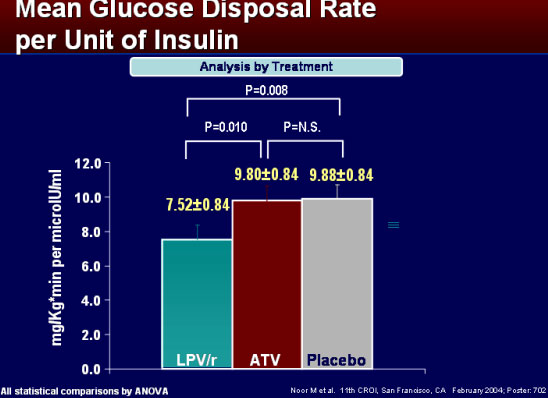 |
|
| |
| |
The difference in M/I between ATV and LPVr was statistically significant (2.28 with 95% CI: 0.58, 3.97; p=0.010). The difference in M/I between LPV/r and placebo was also statistically significant (-2.35 with 95% CI: -4.05, -0.66; p=0.008). The difference in M/I between the ATV and placebo group was not statistically significant.
The adjusted means of non-oxidative component of glucose disposal (glycogen storage) for individuals receiving LPV/r, ATV, and placebo are shown (fig 4b see slide below). There were statistically significant differences in glycogen storage rate between the ATV and LPV/r groups (1.46 with 95% CI: 0.55, 2.36; p=0.003) and between the LPV/r and placebo groups (-1.31 with 95% CI: -2.22, -0.40; p=0.006).
The difference in glycogen storage rates between the ATV and placebo groups was not statistically significant. Percentage changes relative to placebo are shown in figure 5- see slide below.
The adjusted means of fasting lipids for LPV/r, ATV, placebo are shown in figure 6. There were statistically significant differences in fasting triglycerides between the LPV/r and ATV groups (-46 mg/dl, p<0.001) and between the LPV/r and placebo groups (+53 mg/dl, p<0.001). The difference in fasting triglycerides between the ATV and placebo groups was not statistically significant. Percent changes in fasting triglycerides relative to placebo are shown in figure 7 below..
|
|
| |
| |
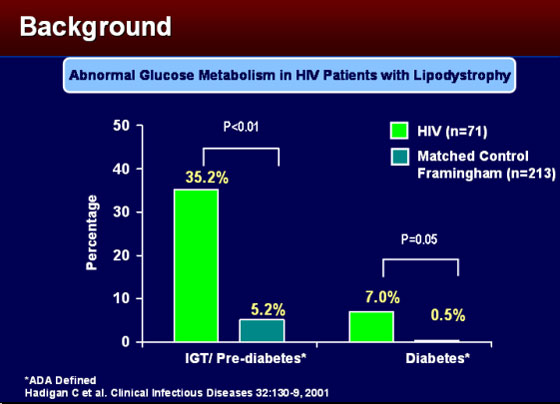 |
|
| |
| |
|
|
| |
| |
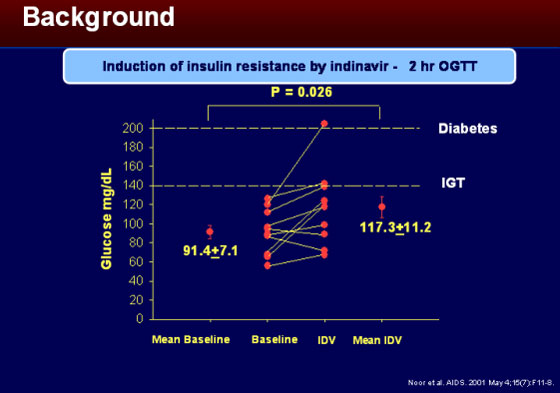 |
|
| |
| |
|
|
| |
| |
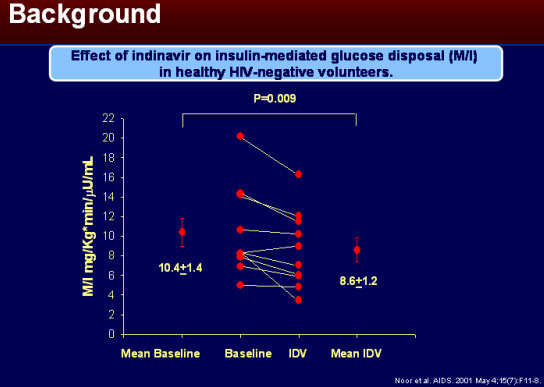 |
|
| |
| |
|
|
| |
| |
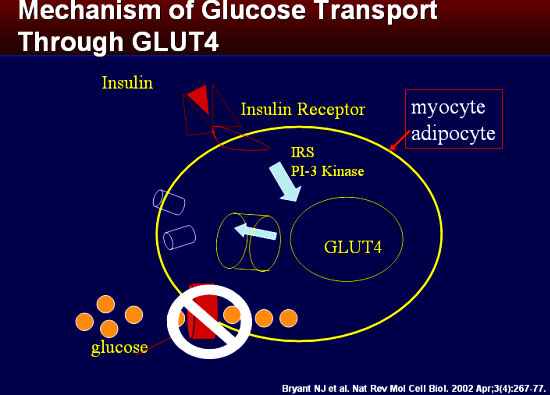 |
|
| |
| |
|
|
| |
| |
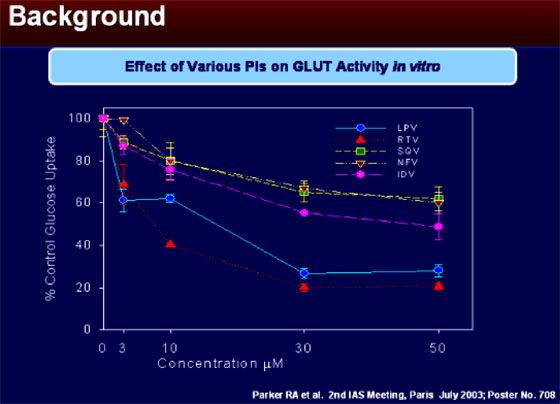 |
|
| |
| |
|
|
| |
| |
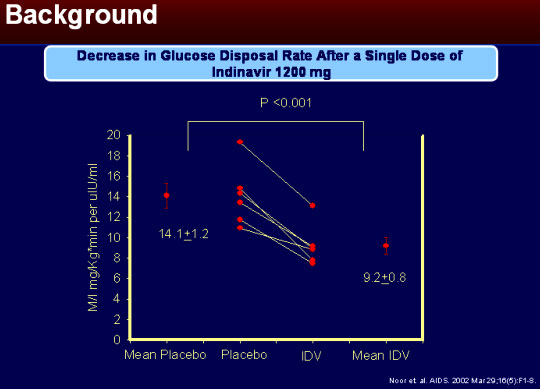 |
|
| |
| |
|
|
| |
| |
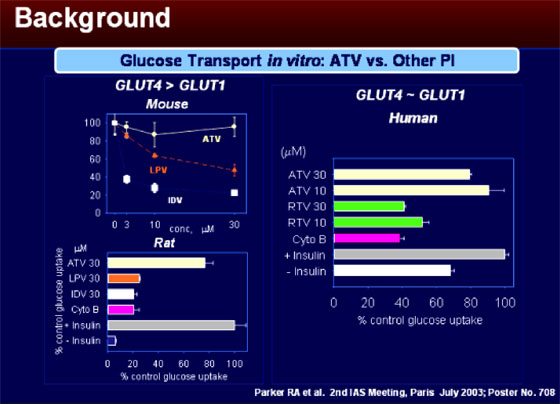 |
|
| |
| |
Figure 4b. Glucose Oxidation and Glycogen Storage Rates
|
|
| |
| |
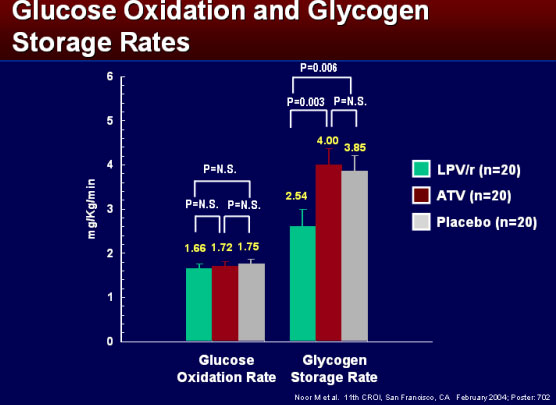 |
|
| |
| |
Figure 5: Effect of ATV vs LPV/r on Insulin Sensitivity
|
|
| |
| |
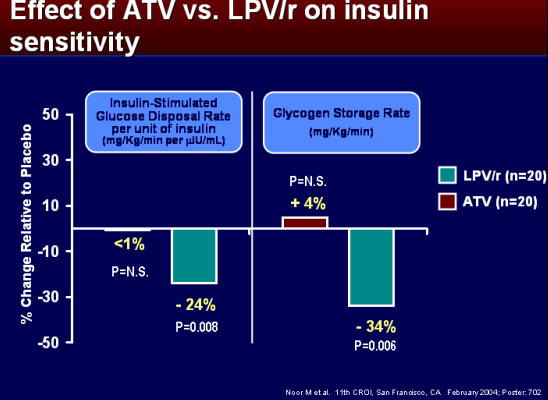 |
|
| |
| |
Figure 7: Effect of ATV vs LPV/r on Fasting Triglycerides (day 6)
|
|
| |
| |
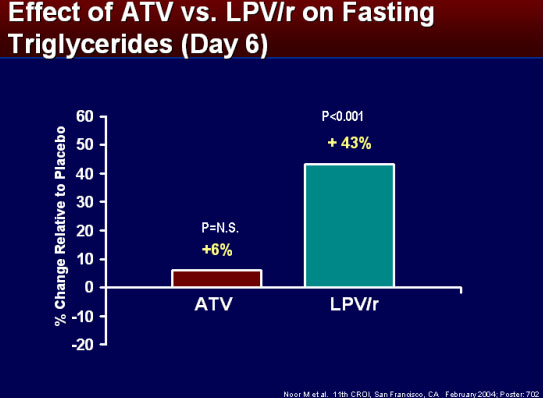 |
|
| |
| |
|
| |
|
 |
 |
|
|